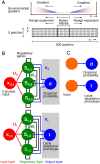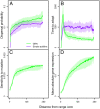Genetic architecture of dispersal and local adaptation drives accelerating range expansions
- PMID: 35895682
- PMCID: PMC9353510
- DOI: 10.1073/pnas.2121858119
Genetic architecture of dispersal and local adaptation drives accelerating range expansions
Abstract
Contemporary evolution has the potential to significantly alter biotic responses to global change, including range expansion dynamics and biological invasions. Models predicting range dynamics often make highly simplifying assumptions about the genetic architecture underlying relevant traits. However, genetic architecture defines evolvability and higher-order evolutionary processes, which determine whether evolution will be able to keep up with environmental change or not. Therefore, we here study the impact of the genetic architecture of dispersal and local adaptation, two central traits of high relevance for range expansions, on the dynamics and predictability of invasion into an environmental gradient, such as temperature. In our theoretical model we assume that dispersal and local adaptation traits result from the products of two noninteracting gene-regulatory networks (GRNs). We compare our model to simpler quantitative genetics models and show that in the GRN model, range expansions are accelerating and less predictable. We further find that accelerating dynamics in the GRN model are primarily driven by an increase in the rate of local adaptation to novel habitats which results from greater sensitivity to mutation (decreased robustness) and increased gene expression. Our results highlight how processes at microscopic scales, here within genomes, can impact the predictions of large-scale, macroscopic phenomena, such as range expansions, by modulating the rate of evolution.
Keywords: biological invasion; environmental gradient; evolvability; gene-regulatory network; robustness.
Conflict of interest statement
The authors declare no competing interest.
Figures




Similar articles
-
Evolution of gene regulatory networks by fluctuating selection and intrinsic constraints.PLoS Comput Biol. 2010 Aug 5;6(8):e1000873. doi: 10.1371/journal.pcbi.1000873. PLoS Comput Biol. 2010. PMID: 20700492 Free PMC article.
-
Evolving mutation rate advances the invasion speed of a sexual species.BMC Evol Biol. 2017 Jun 26;17(1):150. doi: 10.1186/s12862-017-0998-8. BMC Evol Biol. 2017. PMID: 28651517 Free PMC article.
-
Selection on growth rate and local adaptation drive genomic adaptation during experimental range expansions in the protist Tetrahymena thermophila.J Anim Ecol. 2022 Jun;91(6):1088-1103. doi: 10.1111/1365-2656.13598. Epub 2021 Oct 16. J Anim Ecol. 2022. PMID: 34582573 Free PMC article.
-
Evolutionary transitions in controls reconcile adaptation with continuity of evolution.Semin Cell Dev Biol. 2019 Apr;88:36-45. doi: 10.1016/j.semcdb.2018.05.014. Epub 2018 May 19. Semin Cell Dev Biol. 2019. PMID: 29778791 Review.
-
Natural selection on crosstalk between gene regulatory networks facilitates bacterial adaptation to novel environments.Curr Opin Microbiol. 2022 Jun;67:102140. doi: 10.1016/j.mib.2022.02.002. Epub 2022 Mar 3. Curr Opin Microbiol. 2022. PMID: 35248980 Review.
Cited by
-
Evolutionary ecology of dispersal in biodiverse spatially structured systems: what is old and what is new?Philos Trans R Soc Lond B Biol Sci. 2024 Jul 29;379(1907):20230142. doi: 10.1098/rstb.2023.0142. Epub 2024 Jun 24. Philos Trans R Soc Lond B Biol Sci. 2024. PMID: 38913061 Free PMC article. Review.
-
Gene loss during a transition to multicellularity.Sci Rep. 2023 Mar 31;13(1):5268. doi: 10.1038/s41598-023-29742-2. Sci Rep. 2023. PMID: 37002250 Free PMC article.
-
Spatially Varying Wolbachia Frequencies Reveal the Invasion Origin of an Agricultural Pest Recently Introduced From Europe to North America.Evol Appl. 2024 Sep 20;17(9):e70016. doi: 10.1111/eva.70016. eCollection 2024 Sep. Evol Appl. 2024. PMID: 39310793 Free PMC article.
References
-
- Bullock J. M., et al. ., Human-mediated dispersal and the rewiring of spatial networks. Trends Ecol. Evol. 33, 958–970 (2018). - PubMed
-
- Chen I. C., Hill J. K., Ohlemüller R., Roy D. B., Thomas C. D., Rapid range shifts of species associated with high levels of climate warming. Science 333, 1024–1026 (2011). - PubMed
-
- Melbourne B. A., Hastings A., Highly variable spread rates in replicated biological invasions: Fundamental limits to predictability. Science 325, 1536–1539 (2009). - PubMed
Publication types
MeSH terms
LinkOut - more resources
Full Text Sources
Miscellaneous

